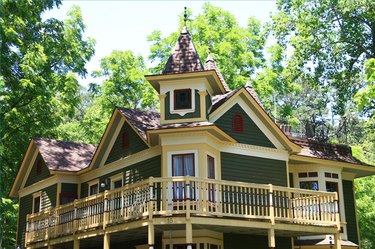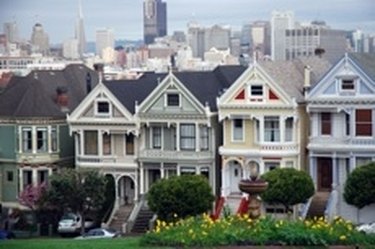
The era of Queen Victoria's reign (1837-1901) was a time of peace and prosperity in Great Britain. The middle class grew, and the Industrial Revolution made mass-produced building supplies readily available to more people. Because of the length of the Victorian era, a variety of house styles and trends overlapped. The term "Victorian architecture" can refer to a number of styles, including Gothic Revival, Italianate, Second Empire, Queen Anne, stick and shingle styles. What characterizes a Victorian house is the use of bold, bright colors; asymmetrical floor plans; and elaborate details.
Gothic Revival
Video of the Day
The Gothic Revival style began in England in the mid-1700s, and its popularity grew rapidly in the early 19th century. Also called Victorian Gothic, it was inspired by the Gothic architecture of medieval Europe and associated with philosophical and social movements.
Video of the Day
Gothic Revival made use of newly available mass production of decorative elements and is distinguished by masonry construction, pinnacles and parapets, vertical lines that brought a sense of height, and stone carvings.
This elaborate style was primarily applied to churches university buildings. Private homes were more restrained. In the United States, more humble versions of Gothic Revival architecture evolved.
Italianate
The Italianate style began in England in the early 1800s and became popular in the 1830s. In the United States, it spanned 1840 to 1880; by the 1860s, Italianate had overtaken Gothic Revival in prominence. The style was common in growing cities in the Midwest, older cities in the Northeast and in San Francisco. Features include a low-pitched roof, angled bay windows, exterior wood painted to resemble more costly stone, a symmetrical shape and tall, narrow windows.
Queen Anne
When most people think of Victorian homes, they probably think of the Queen Anne style, with its elaborate gingerbread trim and bold colors. The style, Old English design with Tudor elements, began in Britain in the 1870s. Queen Anne gained popularity in the United States in the 1880s.
The hallmarks of this style include steeply pitched roofs, an asymmetrical shape, wraparound porches and intricate trimwork. Houses were often painted with five or six colors, including sienna red, hunter green, burnt yellow and brown, to emphasize textures and trim.
Shingle Style
The shingle style, which evolved from Queen Anne and was popular from about 1880 to 1910, is less elaborate than other Victorian-era house styles. It includes shingled surfaces and a horizontal shape that conveys a sense of volume.
Preservation and Restoration

Carroll Avenue, one of Los Angeles' oldest neighborhoods, is a showcase of refurbished Victorian houses. The 1300 block is listed on the National Register of Historic Places, and the street is often used as a backdrop for movies and TV shows.
The term "Painted Ladies" was first used to describe Victorian houses in San Francisco that use three or more colors to enhance their architectural details. The most photographed example is near the city's Alamo Square, known as Postcard Row. The houses there were built between 1892 and 1896.
The Old Louisville neighborhood, which dates from the 1870s, is home to one of the largest preserved districts of Victorian architecture in the United States. By the mid-1900s, the area was in decline as people moved to the suburbs. Revitalization efforts began in the 1960s.